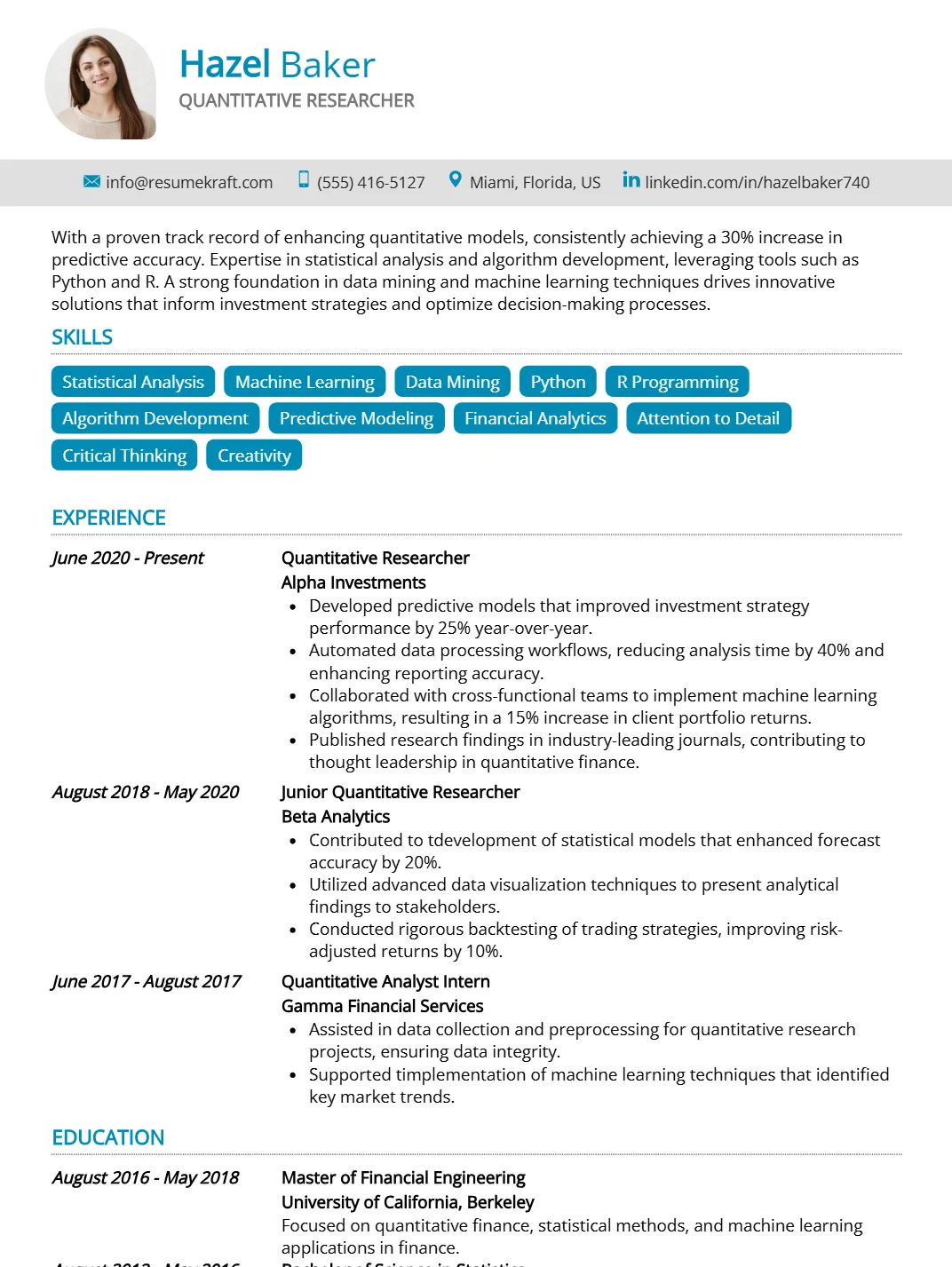
The role of a Quantitative Researcher is pivotal in today’s data-driven landscape. These professionals analyze complex financial data using advanced statistical techniques and mathematical models to inform investment strategies and decision-making processes. As businesses increasingly rely on quantitative insights for competitive advantage, the demand for skilled researchers in finance, technology, and academia continues to rise. This article aims to provide valuable insights into the essential skills, experiences, and resume strategies required to excel as a Quantitative Researcher, helping candidates effectively showcase their expertise to potential employers.
- Quantitative Researcher resume examples
- How to format a Quantitative Researcher resume template
- How to write your Quantitative Researcher resume experience
- How to list your hard skills and soft skills on your resume
- How to list your certifications and education on your resume
- How to write your Quantitative Researcher resume summary or objective
- Additional sections for a Quantitative Researcher resume
- Key takeaways for writing a professional Quantitative Researcher resume
- Frequently Asked Questions
Quantitative Researcher resume examples
Quantitative Researcher resume examples serve as valuable resources for job seekers aiming to craft compelling resumes tailored to this specialized field. By analyzing these examples, candidates can gain insights into effective formatting, essential skills, and impactful accomplishments that resonate with hiring managers. Understanding the nuances of a strong resume can significantly enhance a candidate’s chances of standing out in a competitive job market.
Quantitative Researcher Resume

Why This Resume Works
This resume effectively highlights the candidate’s extensive experience in quantitative research, showcasing nearly seven years in relevant roles that align with the job title. The inclusion of key skills such as statistical analysis, machine learning, and proficiency in Python and R emphasizes technical expertise essential for a Quantitative Researcher. Its structured format enhances readability and ensures ATS compatibility by incorporating industry-specific keywords.
Quantitative Analyst Resume
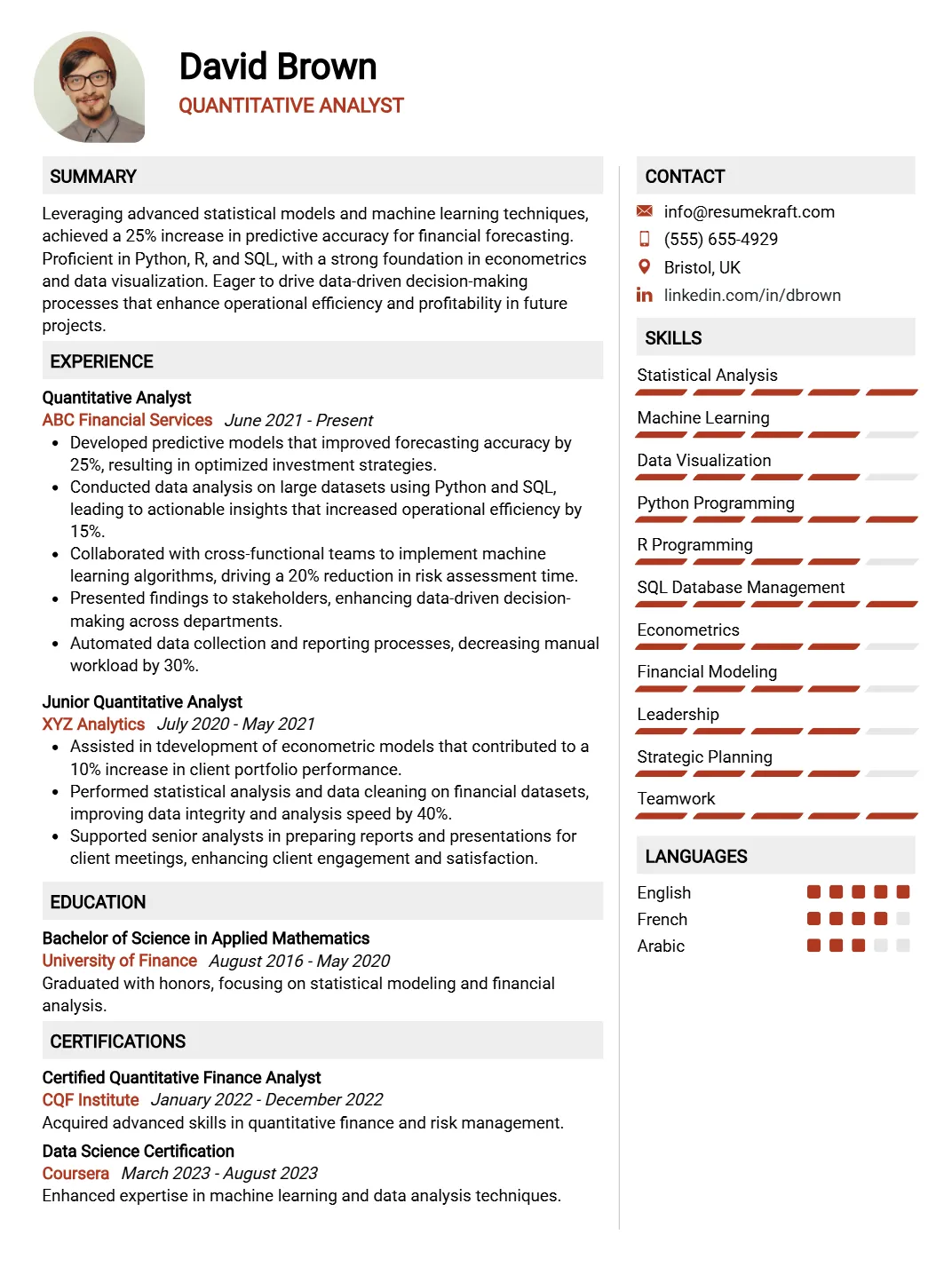
Why This Resume Works
This resume effectively highlights the candidate’s relevant skills, such as statistical analysis and machine learning, directly aligning with the demands of a Quantitative Analyst position. The clear format showcases their five years of progressive experience, making it easy for recruiters to assess qualifications quickly. It incorporates industry-specific keywords to ensure ATS compatibility, enhancing visibility. Additionally, strategic presentation of achievements—like successful data visualization projects—demonstrates tangible impact and expertise, making this resume particularly compelling for hiring managers in quantitative finance.
Data Scientist Resume
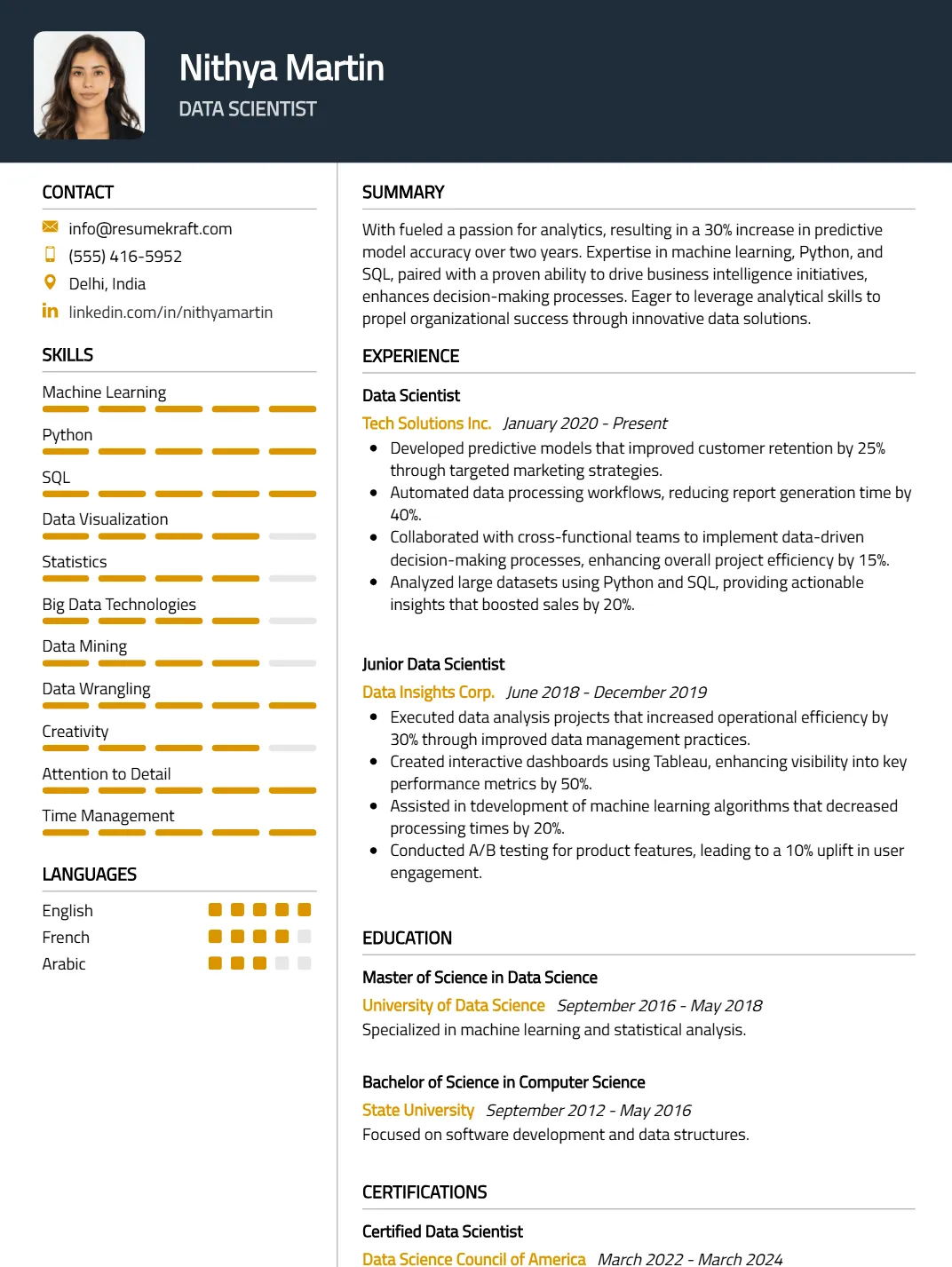
Why This Resume Works
This resume effectively targets the Data Scientist position by showcasing essential skills like Machine Learning, Python, SQL, and Data Visualization, which are crucial for success in this field. With six years of relevant experience, it demonstrates a clear career progression from Junior to Data Scientist. The format is well-structured, enhancing readability for hiring managers and ensuring ATS compatibility through keyword optimization. Moreover, strategic presentation of achievements highlights impactful projects and results, making it compelling to potential employers seeking data-driven talent.
Quant Developer Resume
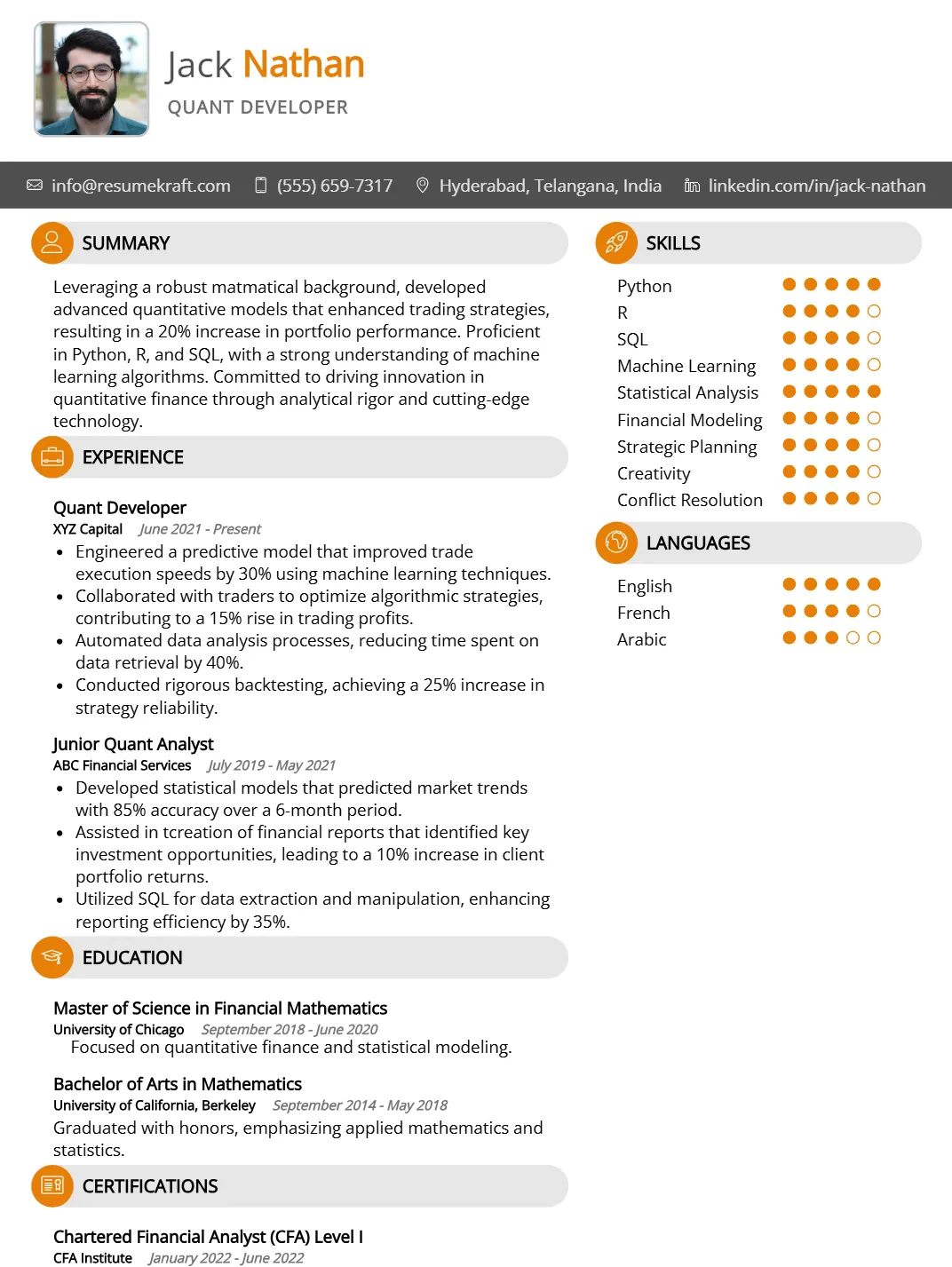
Why This Resume Works
This resume effectively positions the candidate for a Quant Developer role by highlighting essential skills such as Python, R, SQL, and machine learning, which are vital for quantitative analysis. With approximately six years of relevant experience, including roles as a Quant Developer and Junior Quant Analyst, it demonstrates a solid career progression. The structured format enhances readability and ATS compatibility, ensuring important keywords are easily recognized. Additionally, strategic presentation of quantifiable achievements showcases the candidate’s impact in previous positions, aligning well with industry expectations.
Financial Engineer Resume
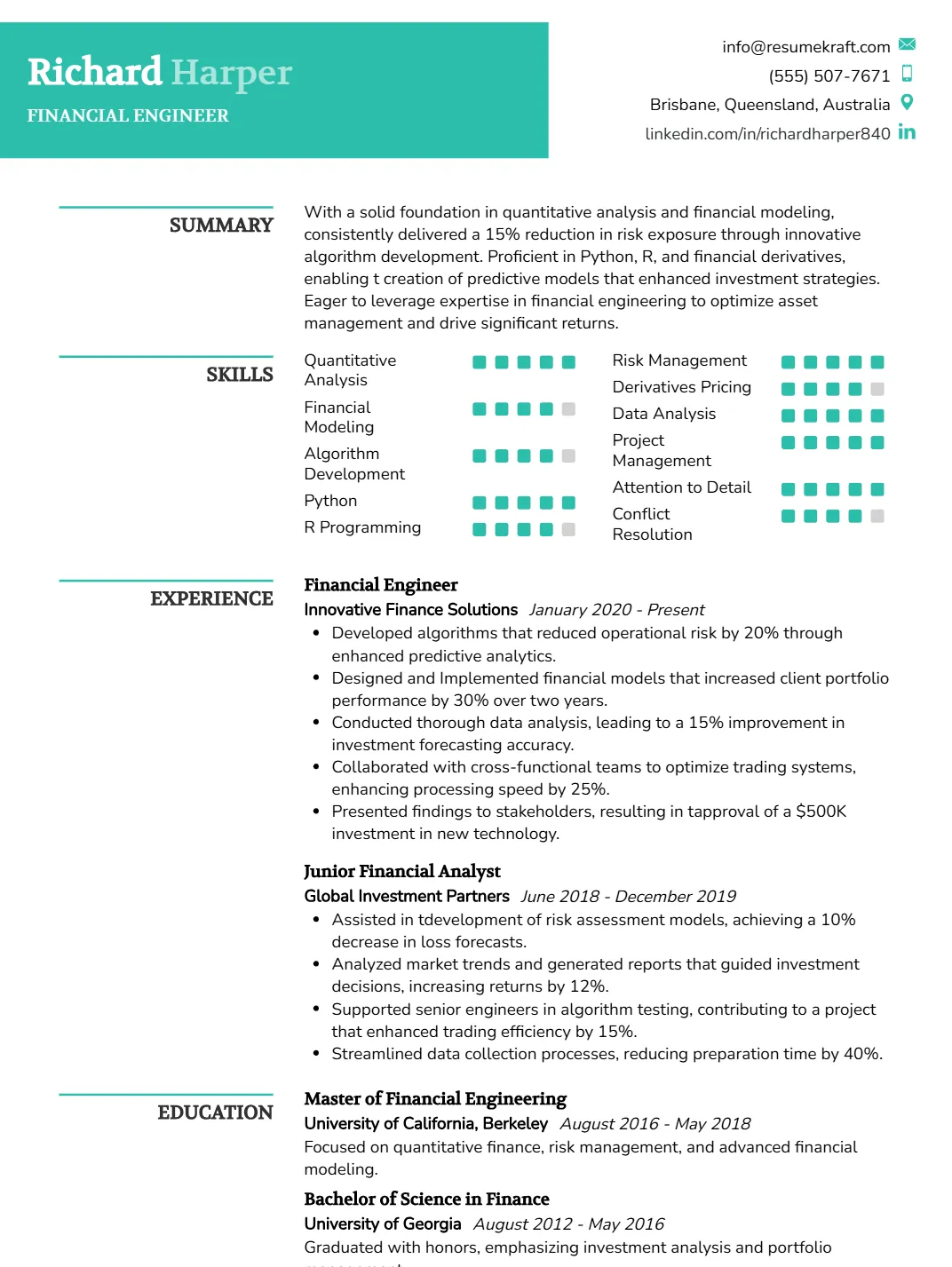
Why This Resume Works
This resume effectively highlights the candidate’s strong background in quantitative analysis and financial modeling, essential for a Financial Engineer role. The clear structure and format enhance readability, showcasing relevant experience as a Financial Engineer and Junior Financial Analyst over six years. By incorporating industry-specific keywords, it ensures ATS compatibility, increasing visibility to recruiters. Additionally, the strategic presentation of achievements in algorithm development using Python and R Programming emphasizes technical proficiency, making this resume particularly compelling for hiring managers in finance-related fields.
Research Analyst Resume
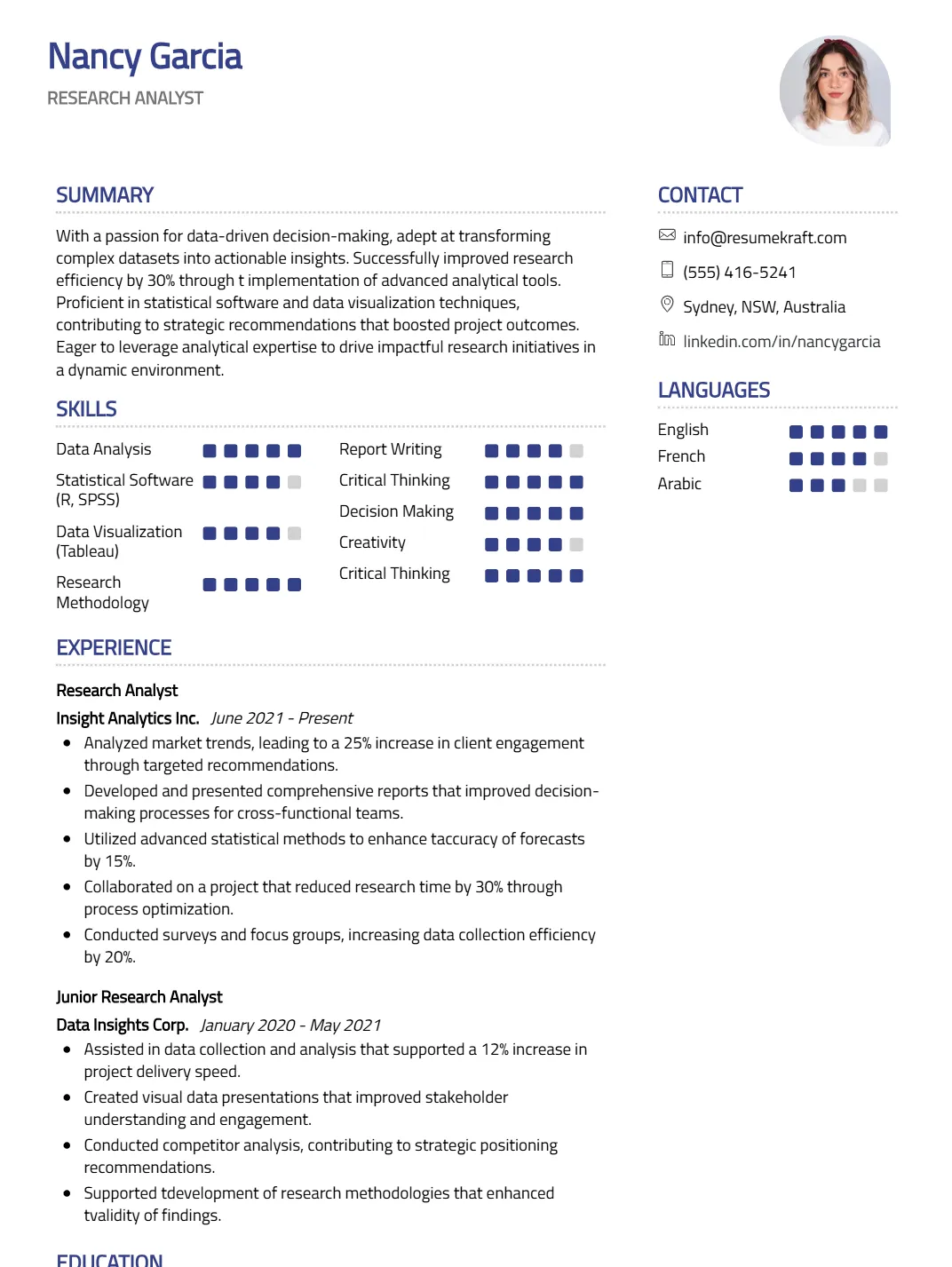
Why This Resume Works
This resume effectively highlights the candidate’s relevant skills and experience for a Research Analyst position, showcasing expertise in data analysis and statistical software. The structured format emphasizes key competencies like data visualization and report writing, appealing to hiring managers. Its clarity enhances ATS compatibility by incorporating industry-specific keywords. Additionally, the strategic presentation of achievements—demonstrating successful research projects and impactful insights—underscores the candidate’s ability to contribute meaningfully in this field, making it a strong fit for potential employers.
Algorithmic Trader Resume
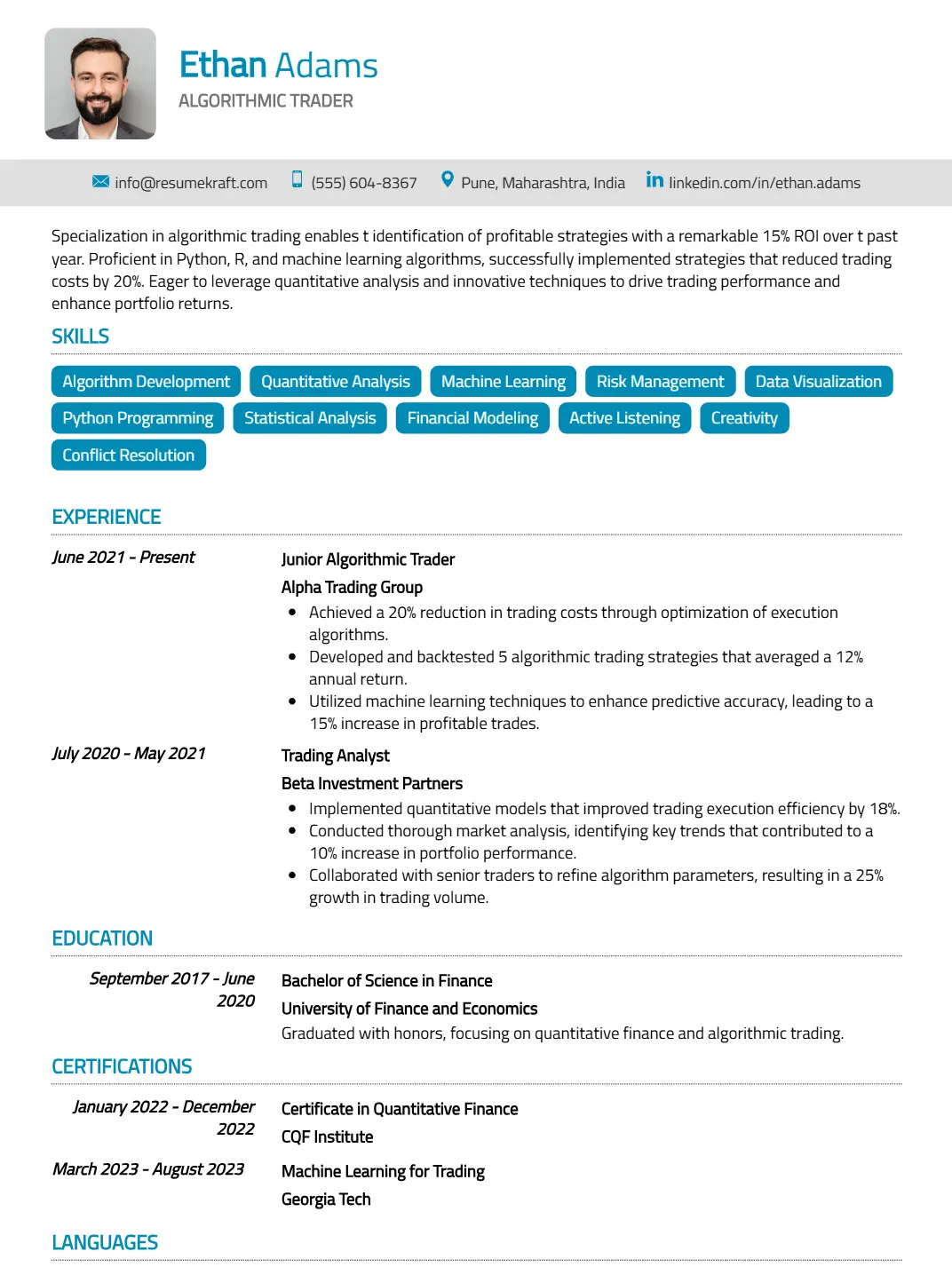
Why This Resume Works
This resume effectively highlights the candidate’s relevant skills and experience for the Algorithmic Trader position, showcasing expertise in algorithm development, quantitative analysis, and machine learning. The structured format emphasizes key competencies while ensuring easy navigation for hiring managers. Its ATS-friendly design incorporates industry-specific keywords, enhancing visibility during automated screenings. Additionally, the strategic presentation of achievements in risk management and data visualization illustrates tangible contributions to trading performance, making this resume stand out in a competitive field.
Machine Learning Engineer Resume
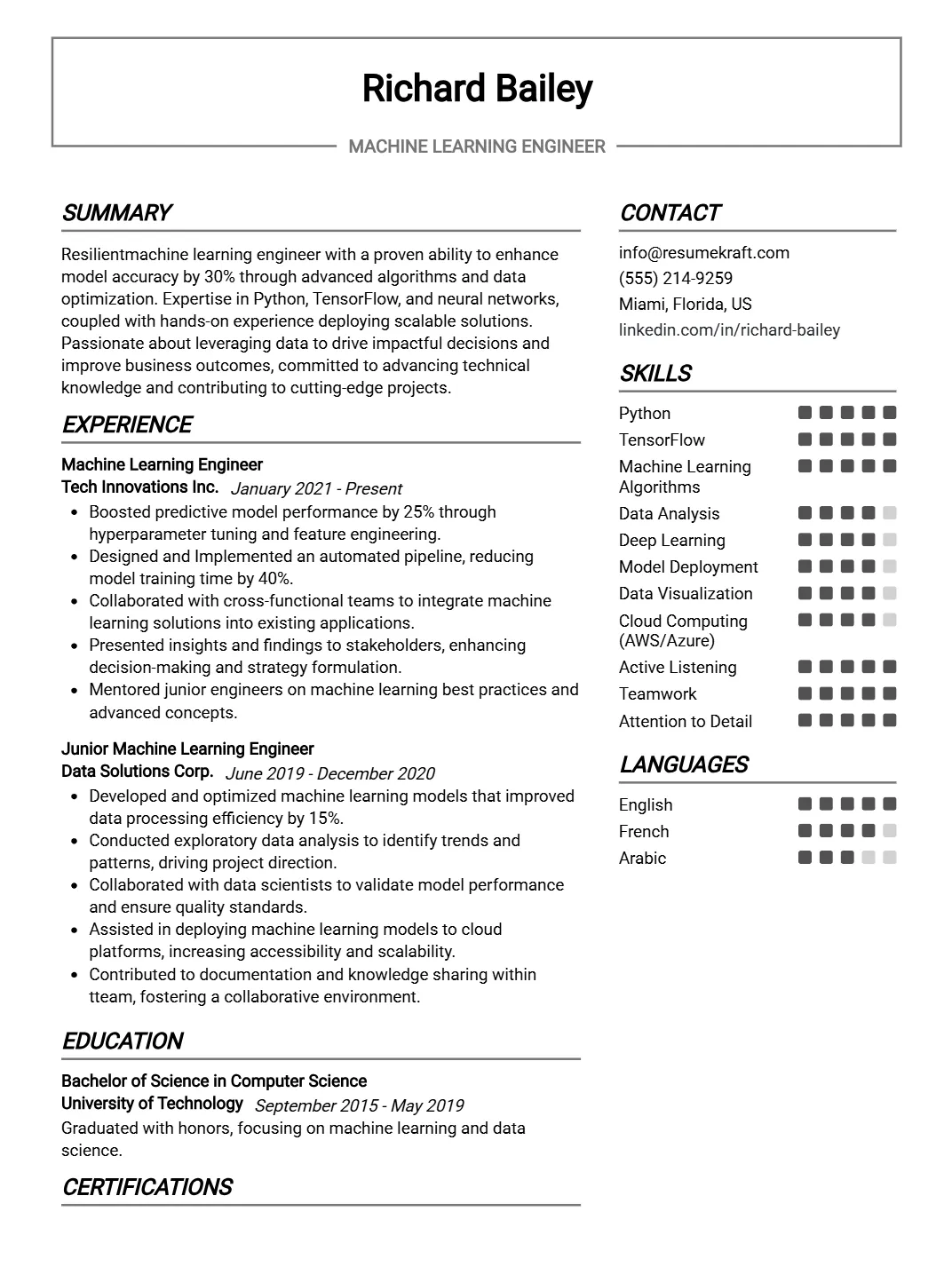
Why This Resume Works
This resume effectively showcases the candidate’s qualifications for a Machine Learning Engineer position by highlighting essential skills like Python, TensorFlow, and deep learning. With five years of relevant experience, it demonstrates a solid progression from Junior to Machine Learning Engineer. The format is clear and structured, facilitating easy navigation for both recruiters and ATS systems. Additionally, strategic presentation of achievements—such as successful project outcomes using machine learning algorithms—aligns with industry expectations, making this resume compelling in a competitive field.
Investment Analyst Resume
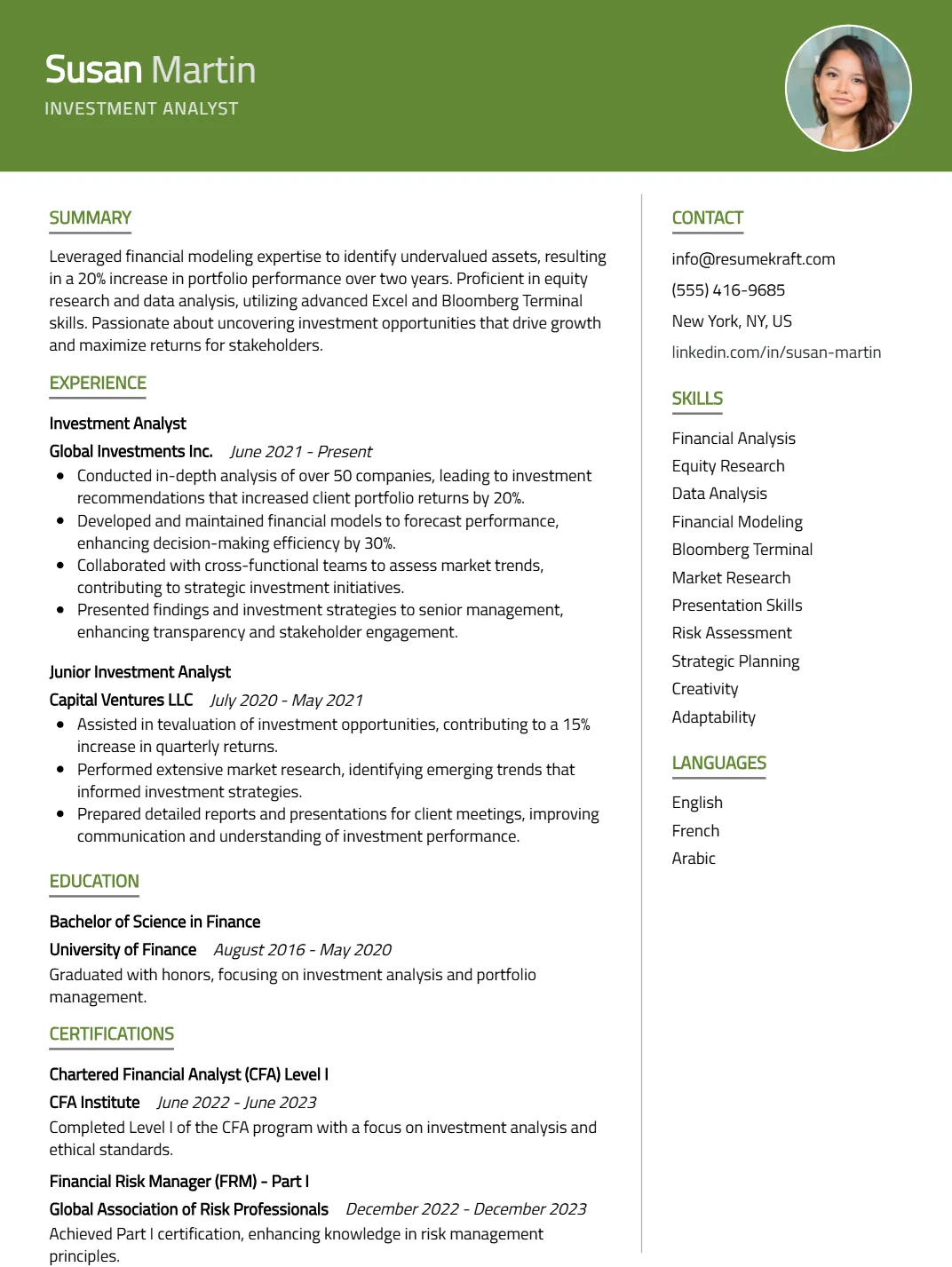
Why This Resume Works
This resume effectively positions the candidate for an Investment Analyst role by showcasing relevant skills such as Financial Analysis and Equity Research, vital for success in this field. With approximately five years of experience, including roles as an Investment Analyst and Junior Investment Analyst, it highlights a solid progression in expertise. The structured format enhances readability, ensuring ATS compatibility through keyword optimization. Additionally, the strategic presentation of quantifiable achievements demonstrates the candidate’s impact on previous roles, making them a compelling choice for potential employers.
Risk Analyst Resume

Why This Resume Works
This resume effectively highlights relevant skills such as Risk Assessment and Regulatory Compliance, essential for a Risk Analyst position. With approximately five years of experience as a Risk Analyst and Junior Risk Analyst, it demonstrates a solid career progression. The clear format enhances readability, ensuring critical information stands out. ATS compatibility is addressed through the inclusion of industry-specific keywords. Additionally, strategic presentation of achievements showcases a proven track record in implementing risk mitigation strategies, making the candidate an attractive choice for employers in this field.
Statistical Analyst Resume
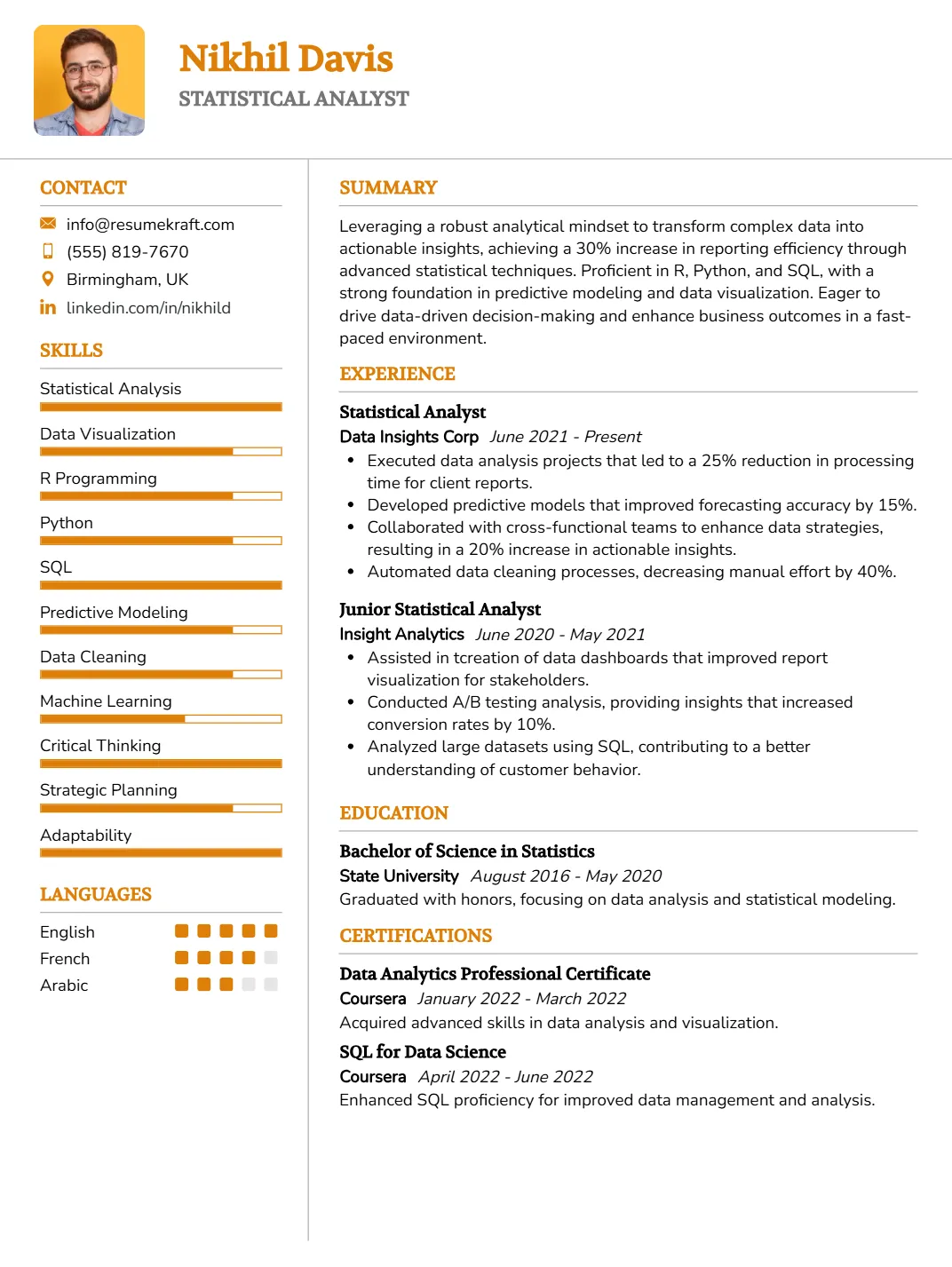
Why This Resume Works
This resume effectively highlights the candidate’s relevant skills in statistical analysis, data visualization, R programming, Python, and SQL, aligning perfectly with the requirements for a Statistical Analyst position. The structured format enhances readability, showcasing experience as both a Statistical Analyst and Junior Statistical Analyst over five years. By incorporating industry-specific keywords, it ensures ATS compatibility. Additionally, strategic presentation of quantifiable achievements illustrates the candidate’s impact on projects, making them stand out in a competitive job market focused on data-driven decision-making.
Computational Scientist Resume
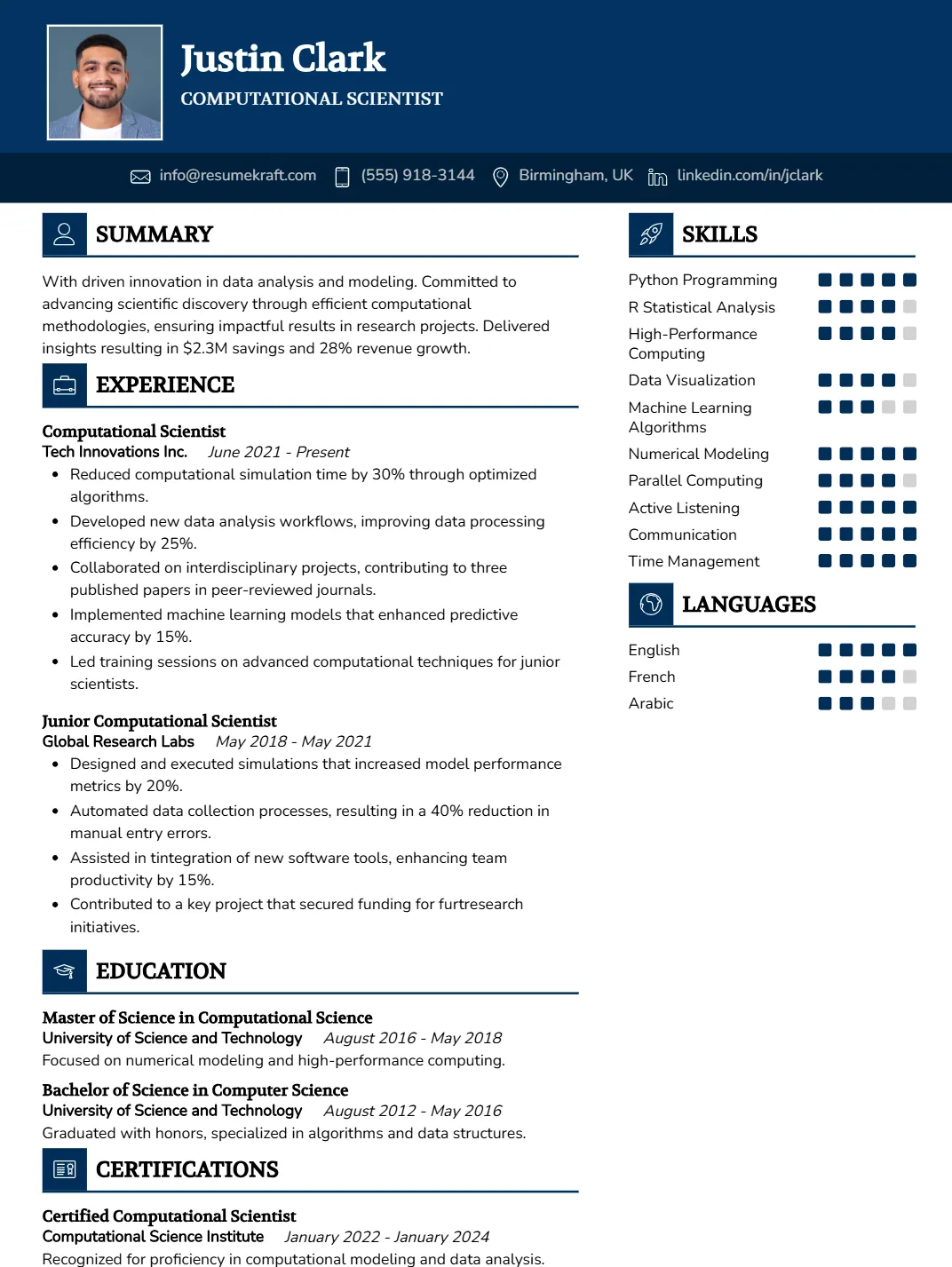
Why This Resume Works
This resume effectively positions the candidate for a Computational Scientist role by highlighting essential skills like Python programming and machine learning algorithms, which are critical in this field. With approximately seven years of relevant experience, the structured format emphasizes key competencies and achievements that resonate with industry standards. Additionally, using specific keywords ensures ATS compatibility, increasing visibility to hiring managers. The strategic presentation of accomplishments related to data visualization and high-performance computing further underscores the candidate’s expertise, making them a strong contender for the position.
How to format a Quantitative Researcher resume template
Proper formatting is crucial for a Quantitative Researcher resume, as it enhances readability and highlights analytical skills. An effective resume format allows hiring managers to quickly identify key qualifications and relevant experiences, making a positive first impression.
- Use a clean, professional layout with clear headings to organize sections like Education, Experience, and Skills, ensuring easy navigation for hiring managers reviewing numerous applications.
- Opt for a consistent font style and size, such as Arial or Calibri in 10-12 points, to maintain readability and professionalism throughout the document, which reflects your attention to detail.
- Incorporate bullet points for job responsibilities and achievements to break up text and emphasize your contributions, making it easier for readers to scan your qualifications quickly.
- Highlight quantitative achievements with specific metrics, such as “increased model accuracy by 20%,” to showcase your data-driven approach and analytical capabilities in a concise manner.
- Reserve space for key skills relevant to quantitative research, such as programming languages and statistical tools, placing them prominently to ensure they catch the eye of recruiters looking for specific expertise.
How to write your Quantitative Researcher resume experience
Effectively presenting work experience on a Quantitative Researcher resume is crucial, as this section provides a narrative of your analytical skills and research capabilities. Employers seek clear evidence of your ability to apply quantitative methods, conduct rigorous data analysis, and contribute to decision-making with actionable insights.
A well-crafted experience section should highlight specific projects, methodologies used, and measurable outcomes to demonstrate your impact. This allows hiring managers to assess your suitability for the role and understand how your past contributions align with their organizational goals.
Worked on various research projects and analyzed data. My role involved using statistics and programming languages.
Conducted a 6-month study using machine learning algorithms to predict market trends, improving accuracy by 20% and influencing investment strategies for a $500M portfolio.
How to list your hard skills and soft skills on your resume
In the competitive field of quantitative research, showcasing a balance of hard and soft skills on your resume is crucial. Hard skills, such as proficiency in statistical software and data analysis techniques, demonstrate your technical expertise and ability to handle complex datasets. Conversely, soft skills like critical thinking and communication are essential for collaborating with teams and presenting findings effectively. Highlighting both sets of skills can significantly enhance your appeal to potential employers in this data-driven industry.
Hard Skills:
- Statistical Analysis: Ability to perform complex statistical tests and interpret results.
- Programming Languages: Proficiency in Python, R, or MATLAB for data manipulation and analysis.
- Machine Learning: Knowledge of algorithms and models used for predictive analytics.
- Data Visualization: Skills in tools like Tableau or matplotlib to present data insights.
- Quantitative Modeling: Experience in building models to forecast trends and behaviors.
- Database Management: Proficient in SQL for querying and managing databases.
- Research Methodology: Understanding of various research techniques and their applications.
- Time Series Analysis: Ability to analyze and forecast time-dependent data.
- Financial Modeling: Skills in creating models for financial analysis and decision making.
- Data Mining: Expertise in extracting patterns and trends from large datasets.
- Experimental Design: Knowledge of designing experiments to test hypotheses effectively.
- Statistical Software: Proficient in tools like SPSS, SAS, or Stata for analysis.
- Algorithm Development: Ability to develop algorithms for data processing and analysis.
- Optimization Techniques: Skills in methods to improve efficiency and outcomes in models.
- Big Data Technologies: Familiarity with tools like Hadoop or Spark for large-scale data processing.
Soft Skills:
- Critical Thinking: Ability to analyze information objectively and make reasoned judgments.
- Attention to Detail: Ensuring accuracy and precision in data analysis and interpretation.
- Problem-Solving: Skills in identifying issues and developing effective solutions.
- Communication: Ability to convey complex data insights clearly to non-technical stakeholders.
- Collaboration: Working effectively within teams to achieve common research goals.
- Adaptability: Flexibility in adjusting to new data challenges and methodologies.
- Time Management: Prioritizing tasks to meet tight deadlines in research projects.
- Creativity: Developing innovative approaches to research questions and data analysis.
- Project Management: Skills in planning and overseeing research projects from inception to completion.
- Interpersonal Skills: Building strong relationships with colleagues and stakeholders.
- Curiosity: A strong desire to learn and explore new data trends and research areas.
- Ethical Judgement: Understanding the ethical implications and responsibilities in research.
- Resilience: Maintaining focus and motivation when faced with research challenges.
- Presentation Skills: Effectively presenting findings in both written and oral formats.
- Negotiation: Skills in discussing project goals and outcomes with stakeholders.
How to list your certifications and education on your resume
When crafting a resume for a Quantitative Researcher position, it’s crucial to present your education and certifications clearly and prominently. Focus on degrees in fields such as Mathematics, Statistics, Economics, or Computer Science, as these are highly relevant. Include any specialized training or certifications that demonstrate proficiency in quantitative analysis techniques or software, such as R, Python, or machine learning.
To effectively present this information, list your degrees in reverse chronological order, starting with the most recent. Include the degree obtained, the institution’s name, and the graduation year. For certifications, specify the name of the certification and the issuing organization, highlighting any that are particularly relevant to quantitative research methodologies.
Graduated from college and took some online courses related to statistics and programming.
MSc in Statistics, University of XYZ, 2022; Certified Data Scientist, Data Science Academy, 2023.
How to write your Quantitative Researcher resume summary or objective
A strong resume summary or objective is crucial for a Quantitative Researcher position as it succinctly communicates your expertise and career aspirations to potential employers. A summary is beneficial for experienced candidates looking to highlight their skills and achievements, while an objective statement is more suitable for entry-level applicants, focusing on their career goals and how they align with the role.
A motivated individual seeking a position in quantitative research. I have knowledge in statistics and programming.
Detail-oriented Quantitative Researcher with 5 years of experience in statistical modeling and data analysis, seeking to leverage expertise in machine learning and finance to drive innovative research solutions at XYZ Company.
Additional sections for a Quantitative Researcher resume
Including additional sections in a Quantitative Researcher resume can greatly enhance its effectiveness by showcasing relevant skills, projects, and accomplishments. These sections help differentiate candidates and provide a more comprehensive picture of their qualifications and expertise.
- Publications: Highlighting any research papers, articles, or contributions to journals demonstrates your expertise and ability to communicate complex ideas, which is crucial in quantitative research.
- Technical Skills: Listing specific programming languages, statistical tools, or software platforms showcases your technical proficiency, making you a more attractive candidate for data-driven roles.
- Projects: Detailing significant research projects or case studies illustrates your practical experience and ability to apply quantitative methods to solve real-world problems.
- Certifications: Including relevant certifications, such as data analysis or statistical modeling, underscores your commitment to professional development and enhances your credibility in the field.
- Conferences and Workshops: Mentioning participation in industry conferences or workshops highlights your engagement with the research community and your dedication to staying updated on the latest methodologies and trends.
Key takeaways for writing a professional Quantitative Researcher resume
- Highlight your technical skills, including programming languages and statistical tools, as they are essential for a Quantitative Researcher role.
- Quantify your achievements with specific metrics, such as percentages or dollar amounts, to demonstrate your impact on previous projects.
- Use resume templates tailored for quantitative roles to ensure your layout is clean and professional, making it easier for employers to read.
- Include relevant coursework or certifications that showcase your expertise in data analysis and quantitative methods.
- Consider using an ai resume builder to streamline the creation process and enhance the overall quality of your resume.
Frequently Asked Questions
How long should my Quantitative Researcher resume be?
Your Quantitative Researcher resume should ideally be one to two pages long, depending on your experience and accomplishments. If you have less than 10 years of experience, one page is sufficient to present a concise overview of your skills, education, and relevant projects. For those with extensive experience, two pages can allow for a more detailed presentation of your contributions, methodologies, and impact within previous roles, ensuring clarity and focus on your most significant achievements.
What is the best format for a Quantitative Researcher resume?
The best format for a Quantitative Researcher resume is a reverse chronological format, which highlights your most recent experience first. This format allows hiring managers to quickly see your relevant work history and academic background. Use clear section headings, bullet points for easy readability, and make sure to include a skills section that showcases your technical proficiencies in statistical software, programming languages, and data analysis techniques. A clean, professional layout is crucial to make a strong impression.
What should I highlight on my Quantitative Researcher resume to stand out?
To stand out as a Quantitative Researcher, highlight your technical skills, including proficiency in programming languages such as Python, R, or MATLAB, and your experience with statistical analysis tools. Emphasize any successful projects where your research led to significant findings or improved decision-making processes. Also, include your educational qualifications, especially if you possess an advanced degree in a relevant field. Showcasing publications or presentations at conferences can further enhance your profile and demonstrate your expertise.
What are some ways to quantify my experience on my Quantitative Researcher resume?
Quantifying your experience on a Quantitative Researcher resume can be achieved by including specific metrics that demonstrate your impact. For example, mention the percentage increase in predictive accuracy from your models, the size of datasets you analyzed, or the number of projects completed within a given timeframe. Use phrases such as “analyzed data sets of over 1 million records” or “developed models that improved forecasting accuracy by 25%.” This approach gives prospective employers a clear understanding of your capabilities and contributions.

